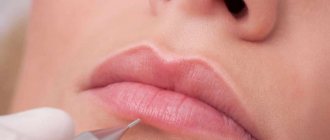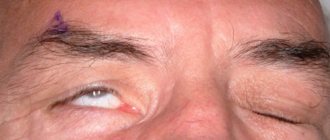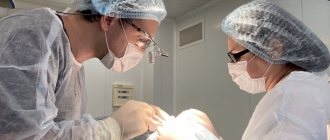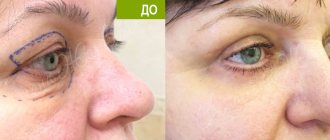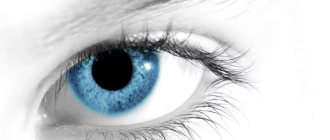Blepharoplasty is an operation aimed at eliminating age-related changes in the upper and lower eyelids or their congenital anomalies. With blepharoplasty, you can remove the overhang of the upper eyelid, swelling and bags under the eyes, correct asymmetry, make the eyes larger and change their shape. As a result, the look becomes more open, lighter, and the face is visually rejuvenated. Blepharoplasty is a fairly common procedure, it is low-traumatic and has a minimal risk of complications.
Rehabilitation after blepharoplasty
The operation is most often performed under local anesthesia. Additionally, the patient may undergo intravenous sedation; he will be in a sleepy state without feeling anxiety or fear. The procedure lasts 1-2 hours. After the patient comes to his senses, he is under the supervision of a doctor for some time. Depending on the clinic’s policy, the scope of the intervention, and the course of the postoperative period, you can go home a few hours after the procedure or spend the first day in the hospital.
At what age is it recommended to have blepharoplasty?
Many patients ask this question. But there is no exact age period when this operation is necessary. Each person has his own special facial anatomy, unique facial expressions, his own genetic history, in the power of which he is. Everyone’s life develops differently, which means living conditions, occupational hazards, eating habits, sleep and rest, bad habits, and ultimately our state of mind. All these factors make noticeable adjustments to the appearance.
Some people at 50 years old do not feel any need to change anything in their appearance, while others at 35, once opening their eyes, cannot recognize their usual image in the reflection. There is a feeling that their changing face no longer matches their inner sense of self, disharmony arises.
Therefore, the indication for blepharoplasty is not the numbers in the passport, but an internal feeling of discomfort and objective anatomical changes requiring correction.
Feelings after surgery
After blepharoplasty, the patient may experience the following symptoms:
- swelling, feeling of heaviness of the eyelids;
- pain in the intervention area;
- hematomas (usually under the lower eyelids);
- dry eyes or, on the contrary, lacrimation;
- diplopia (double vision), blurred vision.
Not all the symptoms from the list will necessarily be present; the appearance of some of them depends on the type of blepharoplasty, the patient’s skin type (swelling is more pronounced on oily skin than on dry skin), lifestyle, diet, compliance with all preoperative doctor’s recommendations and other factors. All these phenomena are reversible and disappear without a trace within a few days or by the end of the recovery period.
When not to have plastic surgery
Blepharoplasty is considered not the most difficult type of plastic surgery, but nevertheless has a number of contraindications. These are mainly conditions common to all types of surgical interventions:
- problems with blood clotting,
- diabetes,
- heart and vascular diseases,
- presence of inflammation,
- infection,
- acute stage of chronic disease,
- oncology.
Also, blepharoplasty is not performed on pregnant and lactating women until the end of the lactation period. Correction is not advisable during menstruation.
In addition to general contraindications, eyelid surgery has its own specific contraindications. These include various diseases of the skin and eyes - conjunctivitis, dry eye syndrome, etc. Some contraindications are temporary. After eliminating them, plastic surgery is possible. If there are permanent contraindications, eyelid correction is not performed.
Rehabilitation period by day
1 day. The patient is discharged from the clinic after the operation. On this day, the eyes are most sensitive to light, so it is recommended to have dark glasses with you to put on before going outside. By evening, swelling increases. Possible lacrimation, dry eyes, blurred vision.
To reduce pain, your doctor may prescribe analgesics. Any medications (drops, ointments) should be used only as prescribed by a doctor. It is necessary to remain calm and avoid any strain on the eyes. You need to sleep on your back, with your head elevated, to improve the flow of fluid from the upper body and reduce swelling.
2-3 days. Painful sensations decrease, swelling, on the contrary, increases, reaching a maximum on the 3rd day. It is acceptable to use a cold compress on the eyes - apply an ice pack wrapped in several layers of clean, dry cloth to the operated area. There may be numbness and impaired sensitivity of the skin in the surgical area.
These days you can already wash your face and hair, trying not to wet the skin of your eyelids. As before, you should try not to strain your eyesight, devote a minimum of time to reading, watching TV, and working at the computer. The patient must continue to follow all the doctor’s prescriptions - drops, treatment of sutures if necessary.
3-5 days. Symptoms persist or improve slightly.
5-7 day . Usually on the 5th day a follow-up examination is scheduled in the clinic, the surgeon removes the sutures (if self-absorbable threads were not used). There may be redness and slight swelling in the area of the sutures.
7-10 days. Symptoms gradually decrease, and by day 10 the patient can return to normal life with some restrictions on eye strain. After 10-14 days you can wear contact lenses.
The final result of the operation can be assessed after 1-2 months. By this time, the epidermis of the skin of the eyelids is renewed, the seams become unnoticeable. After six months, postoperative scars are almost impossible to detect; they look like a thin strip in the crease of the upper eyelid or along the lower edge of the eyelashes.
Who is surgery recommended for?
Indications for correction are predominantly aesthetic in nature and are based on the wishes of the patient himself. For aesthetic purposes, surgery is recommended if there are problems such as:
- eyelid ptosis,
- pronounced wrinkles,
- drooping corners of the eyes,
- excess adipose tissue,
- weakening of the circular muscles,
- stretch marks on the skin.
In some cases, the need for surgery may be due to medical reasons. For example, if there are hernias in the upper eyelid or severe sagging that interferes with normal vision, an ophthalmologist may recommend eyelid surgery.
It is also worth noting that the indications are not always a consequence of age-related changes; sometimes the culprit of wrinkles or ptosis may be individual features of the facial structure or genetic factors. But in most cases, patients aged 45-55 years still seek plastic surgery.
Blepharoplasty services are more often used at older ages.
Nuances of recovery for various types of blepharoplasty
After upper eyelid blepharoplasty, the recovery period is the fastest. Hematomas occur very rarely. Pain and swelling go away faster than with circumferential blepharoplasty and lower eyelid surgery.
Circumferential blepharoplasty and lower eyelid surgery require a slightly longer rehabilitation period, usually lasting up to 2-3 weeks. Swelling and pain are more pronounced, and bruises under the eyes may be present.
Transconjunctival blepharoplasty is performed through an incision on the inside of the eyelid. It is used only for the correction of lower eyelid defects. The least painful method with a quick recovery period, after which there are no scars.
How long does the result of blepharoplasty last?
Age-related changes in the eyelids begin to worry women closer to 25-30 years old. They are associated with loss of skin elasticity, the presence of a large amount of subcutaneous fat, excess skin on the eyelids, etc.
Blepharoplasty helps to neutralize the external manifestations of a number of age-related changes and defects. With its help you can fight with:
- Drooping of the upper eyelid (ptosis);
- Unattractive or vision-impairing eye shape;
- Fatty hernias, excess fatty tissue in the eyelids;
- Asymmetry of the incision;
- Loose eyelid skin, facial and deep wrinkles;
- Chronic “bags”.
How many years do the results of blepharoplasty last? Surgery cannot completely stop the aging process. She can only visually remove its consequences for a certain period.
How long the results of blepharoplasty last depends on you and the surgeon. If the operation was successful, and during the rehabilitation period you followed the doctor’s recommendations, the results will be noticeable from 7 years to 15 years.
Eyelid skin care after blepharoplasty
In the first days after surgery, an antiseptic patch is applied to the stitches. After 2-3 days it is removed. Sutures should be treated with any solutions only on the recommendation of the surgeon; this is not always required. As a rule, sutures are removed 5-7 days after surgery.
No special eyelid skin care is required after blepharoplasty. You need to follow normal hygiene rules, try not to cry or rub your eyes. You can use your usual cosmetics after the stitches are removed and the scars are completely healed. To quickly resolve scars, the doctor may recommend a special gel, but it is not recommended to use it without a prescription.
Indications for eyelid correction
Many patients want to know how blepharoplasty is performed and what indications there are for it. Most often it is performed for aesthetic reasons. These include:
- sagging skin of the upper eyelid
- protruding under-eye bags
- wrinkles, sagging muscles, excess skin under the eyes
- desire to correct the eye contour.
In some cases, surgery is performed for medical reasons. This is due to significant skin ptosis due to age-related changes. In some patients, the skin “lies” on the eyelash edge, closing the viewing angle and preventing the eyes from fully opening.
Current question: at what age is it better to have blepharoplasty? The main thing is not age, but the availability of evidence. They may be present at age 25 or absent at age 45.
A step to prolonging youth is a consultation with a plastic surgeon. Now Svetlana Rabotenko conducts video consultations. The specialist will determine the indications for the operation and tell you about the features of its implementation.
Recommendations to speed up rehabilitation
To quickly recover after blepharoplasty and achieve optimal surgical results, additional procedures are indicated:
- Massage of the skin around the eyes and eye gymnastics. They help improve blood circulation in the intervention area and strengthen the orbicularis oculi muscle. The surgeon who performed the operation will tell you when you can start these procedures, advise the correct massage technique, and show you exercises for the eyes.
- Physiotherapy. Microcurrent therapy is most often used, which normalizes lymph flow, eliminates swelling, and accelerates skin healing. Also shown are UHF and phonophoresis.
- Maintaining sufficient skin hydration. Cosmetic products should be used after scars have healed.
Blepharoplasty. Properties and principles of the technique.
Blepharoplasty is an operation to get rid of excess fatty tissue and skin localized in the eyelid area (lower and upper). The use of this technique is justified due to its proven effectiveness and safety. In addition, this procedure in most cases allows you to forget about the hated bags under the eyes for a long time and correct the shape of the eye shape. It should be noted that this operation does not have strict age restrictions - thus, world practice shows that people begin to resort to it from the age of 20 (mainly in Asian countries; residents of Europe, due to their traditions and habits, are more conservative, so they resort to to plastic surgery mainly after reaching 40 years of age).
Restrictions after surgery
Most prohibitions are temporary and must be adhered to until the end of the rehabilitation period (from 1-2 weeks to 1-2 months).
After blepharoplasty you cannot:
- expose your eyes to bright light and sunlight;
- allow excessive visual strain;
- experience physical activity, including active sports;
- lift weights;
- visit the bathhouse, sauna, solarium;
- rub your eyes;
- wear contact lenses;
- sleep face down or without a pillow;
- apply decorative cosmetics;
- try to remove stitches and healing crusts yourself;
- eat spicy, salty foods, smoked foods;
- smoking and drinking alcohol.
Subsequently, it is necessary to constantly apply a cream with a high sun protection factor to the skin around the eyes. Minimally invasive cosmetic procedures (Botox, mesotherapy) are allowed 2-3 months after surgery.
Possible complications
Blepharoplasty is known as an intervention with a minimal percentage of complications. However, some unpleasant consequences are still possible. Among them:
- hemorrhage in the sclera of the eye;
- hyperreaction to light;
- severe and prolonged lacrimation;
- inflammatory processes in the suture area;
- inflammation of the conjunctiva
- eversion of the century.
Sometimes these phenomena go away on their own; in some cases, medication is required. If, a few days after the operation, cutting pain, redness of the conjunctiva, an increase in previously minor symptoms, hyperemia or suppuration of the sutures, or an increase in body temperature appear, you should urgently contact the clinic where the intervention was performed.
Choosing a clinic and doctor with a good reputation, positive reviews, as well as following all the doctor’s recommendations in the pre- and postoperative period will help minimize the risk of complications.
